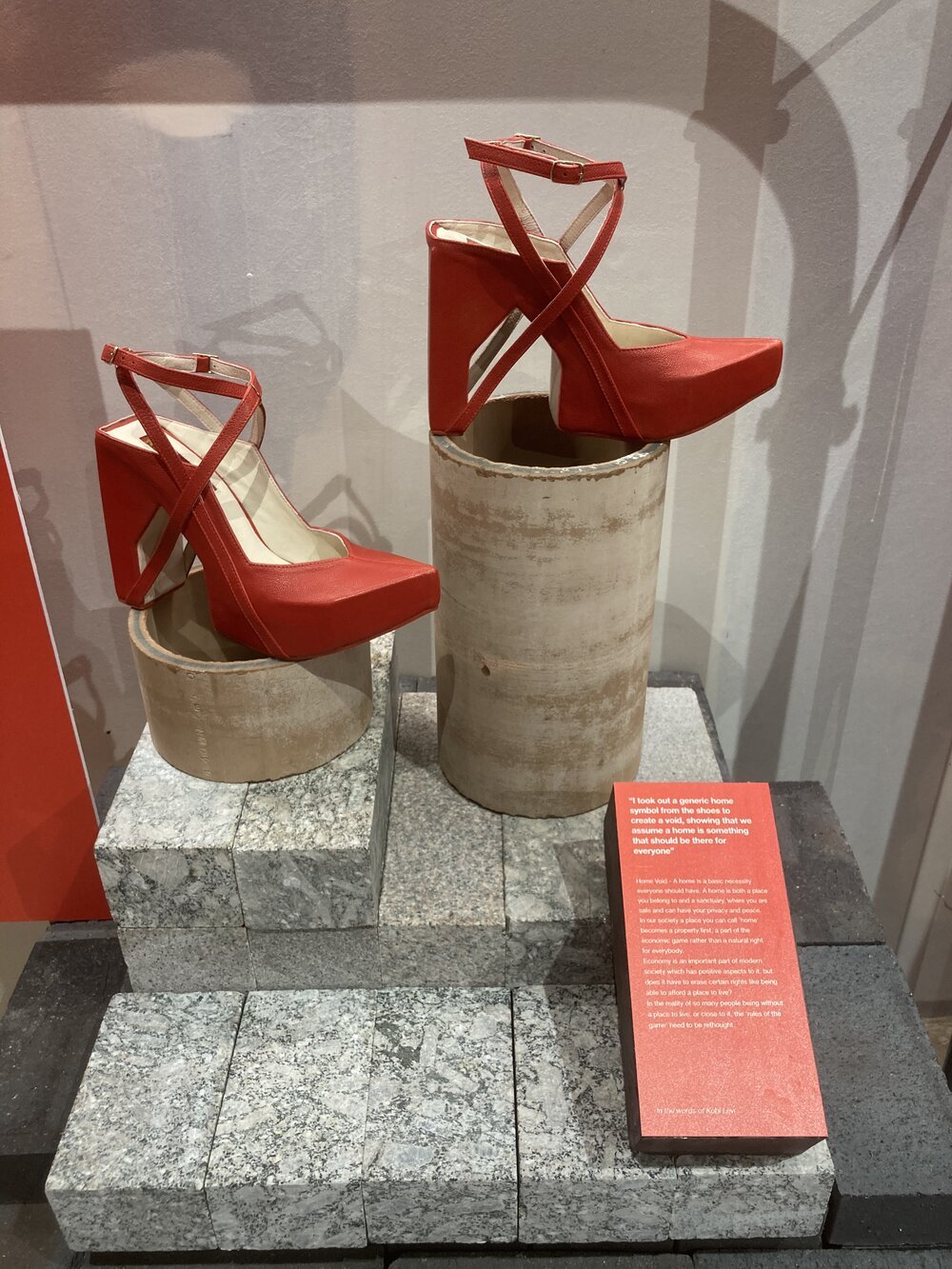Introducing: Jo Cope
In the first of a regular feature introducing our esteemed Network contributors, it is my pleasure to shine the spotlight on our newest addition, fashion artist and conceptual designer Jo Cope.
Jo describes herself as a contemporary fashion artist working between craft and performance; she has made a career from using fashion garments and artefacts to explore the notion of being human. Shoes, which she describes as a “brilliant vessel to tell stories”, are a key artistic and philosophical medium which, she explains, is due to their cultural ubiquity, symbolic potency and metaphorical potential.
Importantly, many of the stories Jo tells–often with her trademark red shoes–have a social and cultural agenda; using seemingly superficial and beautifully crafted items, she entices viewers to engage with challenging and often confronting themes. Since studying Fashion Design at Nottingham Trent University in 2006, and later, a Master’s degree in Fashion Artefacts from the London College of Fashion, Jo has been prolific in establishing the legitimacy of fashion as a form of art.
‘Looking for Love’, 2016, Jo Cope
While Jo has an impressive list of achievements including exhibiting at A History of Shoes at The Decorative Arts Museum Paris (2020), a Solo performance for The Venice Design Biennial (2021) and a solo installation and performance at The Garden Museum for London Craft Week (2022), it was her 2020 collaboration with the British homeless charity Shelter that first sparked my attention in my capacity as a Fashion Design lecturer.
At that time, I had been teaching a course encouraging students to use fashion and textiles as a medium to effect positive social, cultural or environmental change. Our mutual friend and fellow Network contributor Ellen Sampson introduced us and Jo kindly granted me an interview to provide the students with some insights into how to generate meaningful and authentic collaborations that address real-world problems.
The collaboration with Shelter paired ten shoe designers with ten previously homeless people to come up with conceptual and commercial designs that represented their stories and raised awareness of homelessness. The outcome was the exhibition Shoes Have Names at Boutique by Shelter during London Craft Week (2020), which, far from a depressing statement about homelessness, was a positive affirmation of the participants' journeys, hopes, dreams and aspirations. For Jo, shoes were key to this process, explaining that as vessels or voids they invite the viewer to fill them; to identify and empathise with the stories and people they represent. Indeed the project highlighted the power of garments, particularly shoes, as tools to bring communities together, create dialogue and learn from one another–a wonderful lesson for my students!





The emotional, one might even say affective, experience of Jo’s work has perhaps most clearly been captured in her recent conversation with fashion critic and scholar Johannes Reponen for the book Crafting Anatomies: Archives, Dialogues, Fabrications (2022). In their chapter ‘Disarmed: Creating Lasting Impressions’ Jo recalls Twisted Stiletto (2016), a piece of “design fiction” in which a distorted last was used to communicate the “potential disparity between mental and physical states when presenting oneself to others”. When exhibited at YKK’s London Showroom for London Craft Week as part of an installation titled Lessons in Love (2018) she explained, “one of the visitors looked down at the Twisted Stiletto saying ‘That’s me, that is exactly how I feel’”. The way Jo’s work plays with the blurred boundaries between bodies (of both wearers and viewers) and objects is certainly part of its allure and impact.
Twisted Stiletto, Jo Cope, 2016
These important connections between materials, symbolism and bodies are further explored through the performative aspects of Jo’s work. In the same chapter, she discusses with Reponen a performance commissioned by the London College of Fashion to create a collaboration with choreographer Lee Griffiths for the LCF x Sadler’s Wells Material Movement Gala in 2017. For this piece, she created a series of ambiguous and “suggestive” foot objects that existed statically on stage to be brought to life by the dancers. She explains that rather than seeing shoes as a costume or prop, here they played a central role by enabling the concept and leading the choreography. In this context, “[f]loor-sliding motions and lifting actions replaced classic walking motions”, consequently the choreographer and dancers were required to collaborate with the objects to generate the performance. As I have discussed elsewhere, a previous academic focus on the semiotics of shoes as signifiers has continued to neglect the critical importance of wearers and bodies in the production of meaning. For those familiar with Marcel Mauss’ essay Techniques of the Body (1973 [1935]), the piece beautifully demonstrates the role of materials and objects in conjunction with bodies in motion for re/producing culture.
In conclusion, we are extremely lucky to have Jo as our newest contributor, not least for her impressive experience, knowledge and love of shoes, but also for her networking abilities. As one of life’s natural connectors, her genuine interest in other people and passion for bringing them together makes her a wonderful asset.
You can learn more about Jo’s projects at www.jocope.com and if you missed the ‘Shoes Have Names’ collaboration with Boutique by Shelter, the works are currently being shown at the ‘Fitting In’ exhibition at Z33 in Belgium (02.10.2022 - 26.02.2023). To connect or keep up-to-date with Jo’s projects, find her on LinkedIn, Instagram and Twitter.
References:
Cope, J. & Reponen, J. (2020). Disarmed: Lasting Impressions. In: Townsend, K., Solomon, R. & Briggs-Goode, A. (eds.) Crafting Anatomies: Archives, Dialogues, Fabrications. New York: Bloomsbury Publishing.
Mauss, M. (1973 [1935]). Techniques of the Body. Economy and Society, 2, 70-88.
Sherlock, A. (2022). The Footwear Research Network: Reading List [Online]. Melbourne: www.footwearresearchnetwork.org. Available: https://footwearresearchnetwork.org/reading-list [Accessed 10.10.2022 2022].



